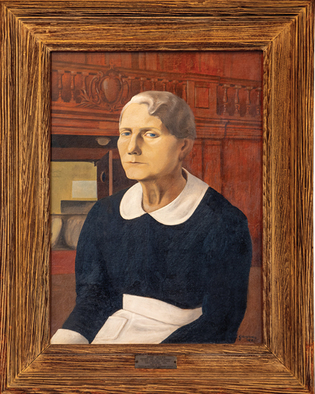
Annie Allen, waitress
Artwork: 1950, by Sante Graziani ’48MFA, 1920–2005
Davenport College Dining Hall
I had read about Brenda Zlamany’s 2018 diptych, Davenport Dining Room Scene, and was eager to see the paintings in person. After viewing the paintings, which were indeed lovely, my eyes wandered to the other portraits hanging from the adjacent walls. In one corner I spotted a small portrait of a woman in a uniform. A label affixed to the frame read: “Ann Allen, Faithful and Beloved Servant in this Dining Hall, 1933–1950.” Ann had been with Davenport since the first year of Yale’s residential college system. What was her story?
The 1950 census showed Ann Allen as one of fifteen lodgers living at 128 York Street—probably a boarding house. She was a widow, 65 years old, an Irish immigrant and naturalized US citizen. Her occupation was listed as “Waitress, University Dining Hall.” The artist, Graziani, chose for this portrait the medium of tempera on board—an ancient artistic method enjoying a revival in the mid-twentieth century.
In fact, in 2002 the portrait was included in the blockbuster exhibit Milk and Eggs: The American Revival of Tempera Painting, 1930–1950, at the Brandywine River Museum. Ann Allen’s visage was exhibited with works by Thomas Hart Benton, Jacob Lawrence, and Andrew Wyeth, among others. I wonder what Annie would have made of that.
 loading
loading